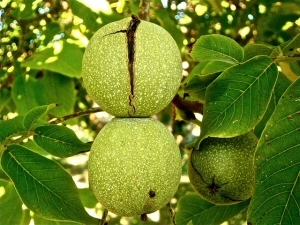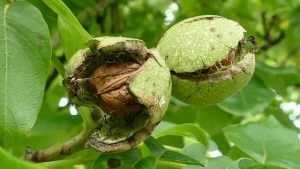Black walnut drupes contain juglone (hydroxy-naphthoquinone), plumbagin (yellow quinone pigments), and tannin. These compounds cause walnuts to stain cars, sidewalks, porches, and patios, in addition to the hands of anyone attempting to shell them. The brownish-black dye was used by early American settlers to dye hair. According to Eastern Trees black walnuts make a yellowish-brown dye, not brownish-black. The apparent confusion is easily explained by the fact that the liquid (dye) obtained from the inner husk becomes increasingly darker over time, as the outer skin darkens from light green to black. Extracts of the outer, soft part of the drupe are still used as a natural dye for handicrafts. The tannins present in walnuts act as a mordant, aiding in the dyeing process, and are usable as a dark ink or wood stain.






